Click Here for Mono SAR Helicopter Training Pictures
The National Park Service provides this manual: National SAR Academy Helicopter Rescue Techniques Training Manual (2013) PDF
Movie by Natai Endo
Probably, the greatest technological instrument utilized in search and rescue today is the helicopter. These machines allow quick and easy access to virtually any wilderness area. They also permit extrications from all but the most inaccessible areas. Modern helicopters can operate in bad weather, darkness, and at high altitude, even above 20,000 feet.
The most important advantage of this evacuation method, however, is that it significantly reduces the time it takes to get an injured person to medical help.
Any search and rescue team member can be called upon at any time to assist with a rescue involving a helicopter. Therefore, it behooves all of us to be, at least, somewhat familiar with the helicopter and the proper techniques that need to be employed while working around this aircraft.
The Machine
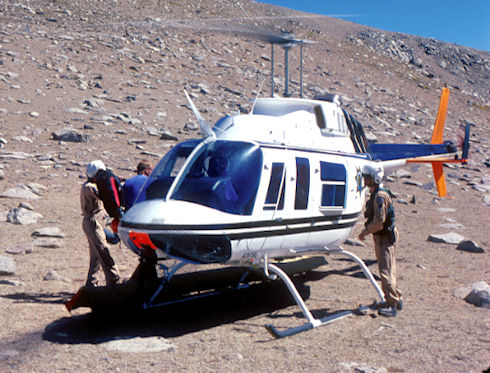
A helicopter is not an airplane, per se. News reporter Harry Reasoner very accurately described the differences on his newscast. "The thing is, helicopters are different from planes. An airplane by its nature wants to fly, and if not interfered with too strongly by unusual events or by a deliberately incompetent pilot, it will fly. A helicopter does not want to fly. It is maintained in the air by a variety of forces and controls working in opposition to each other, and if there is any disturbance in this delicate balance, the helicopter stops flying, immediately and disastrously."
Does this mean that these machines are dangerous? Obviously, but then all flying is at least somewhat dangerous. Also, while helicopters have certain disadvantages when compared with airplanes, they can do several things that could never be done in a normal airplane. While a helicopter cannot glide like an airplane, it can do something even better in some situations. It can "auto rotate" to a relatively soft landing.
There are two basic helicopter designs. The most common type has a large, horizontal main rotor on top and a smaller vertically placed rotor on the tail. Both rotors operate the same as the wing of an airplane. Air flowing over the rotor blade moves faster over the top of the blade than it does over the bottom, thus creating lift. Therefore, since the main rotor moves horizontally, it controls altitude, speed, and direction. When this main rotor spins, however, it creates a tremendous amount of torque. Without something to balance this torque, the main body of the helicopter would be forced to spin in the opposite direction of the main rotor. The vertical tail rotor creates lift just like the main rotor, but the lift is generated at a right angle to the torque generated by the main rotor. This action balances the main rotor torque and allows the helicopter to fly straight. The second design involves larger helicopters which have two, large horizontally-placed main rotors, and no tail rotor. The torque is balanced by having each of the main rotors spinning in opposite directions.
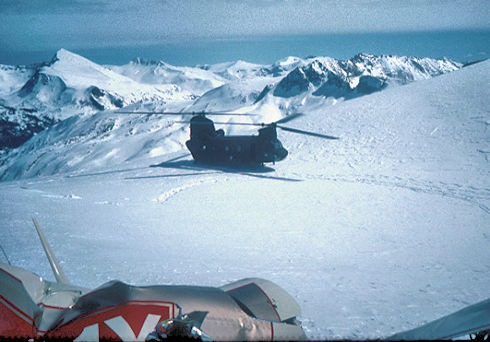
The four main flight controls on a helicopter are the collective, the throttle, the cyclic, and the foot pedals. The collective is a circular bar located to the left of the pilot that, when moved up or down, changes the pitch of the rotor blade. The steeper the pitch of the rotor blade, the greater the generated lift.
Also located on the collective is the throttle. With a twisting motion of the throttle, the pilot controls the power output of the engine(s). This, along with the collective, controls the speed and lifting power of the helicopter.
The cyclic, a control stick located between the pilot’s legs, adjusts the tilt of the main rotor, thus controlling the direction of horizontal movement.
Lastly, the foot pedals change the pitch of the tail rotor blades, allowing the helicopter to rotate around its vertical axis.
While in flight, a helicopter utilizes three different aspects of lift. While near the ground, usually a distance at or less than one half the radius of the main rotor, the aircraft is said to be "in ground effect." This means that the rotor wash is being reflected from the ground, thus, providing greater lift.
If the helicopter is more than one diameter of the rotor above the ground, it is "out of ground effect," and must rely totally on its own power to remain in the air. This is the most hazardous aspect of helicopter flight. Translational lift occurs once the helicopter enters horizontal flight. As horizontal airflow over the main rotor is increased, vortices and turbulence are left behind, and the main rotor begins to work on undisturbed air. This increases main rotor efficiency and lift.
General Considerations
Overall, the most important concept that must be fully understood about helicopters is that being around them is extremely dangerous. Safety must always be the prime concern. If you don’t feel that you have the necessary skills, or can operate within the required safety parameters, the responsibility should be given to another individual who meets both requirements.
Almost as important is the hard and fast rule that only one person can be in charge of the ground operation. This is not to say that the person in charge cannot accept advice from others, but there must be only one recognized authority to make final decisions. It is also extremely critical that the most experienced and qualified individual available be put in charge of any operation involving helicopters.
Selection of a Helibase/Helispot
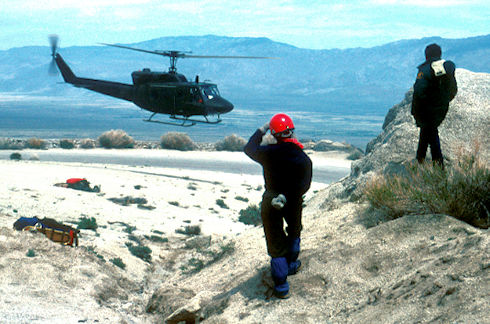
A helibase is usually located at or near the main rescue base. It is the main helicopter base from where all personnel are transported. A helispot is usually the remote location in the field to which individuals are being transported.
There are two basic concepts that form the basis for the selection of a good helibase/helispot. The first is that helicopters, like all aircraft, are more efficient if they can both take off and land into the wind. Secondly, the ideal landing pattern will have the helicopter come out of translational lift directly into a hover in ground effect, then to a landing. On takeoff, the helicopter should transition directly from a hover in ground effect into translational lift. Obviously, the idea is to spend as little time as possible in a hover out of ground effect.
If it is absolutely necessary, however, the pilot can hover out of ground effect over a small landing area, drop straight down to the helispot, then reverse the process for take off. But this option is a last resort as out of ground effect hover puts the most mechanical stress on the helicopter’s engine and other moving parts. Also, the necessity of operating in tight quarters puts much more physical and mental stress on the pilot and crew. Lastly, out of ground effect hovering is usually carried on at an altitude much lower than is necessary for auto rotation in case of mechanical failure. It is, therefore, the least safe alternative because it leaves virtually no room for error.
A good helibase, therefore, will have clear approach and departure lanes in all directions, and will be as flat as possible, sloping not more than ten degrees. The best helibase will be in a field, or other exposed area, roughly the size of a football field. This allows the pilot the widest choice of options with regards to approach, departure, and landing possibilities. Obstructions, such as trees and power lines, should be avoided as much as possible.
A twenty-foot area in the middle of the helibase should be identified as the actual landing area. At least a one-hundred-foot area around this spot should be cleared of all loose items. Each helibase should also have a wind direction indicator. This can be a piece of paper or plastic tape tied to any object visible from the air, a smoky fire, a handful of dirt thrown into the air, or a smoke bomb activated downwind from the landing area. Each of these methods will also give the pilot an idea of wind speed. Also, a person can stand with his/her back into the wind with both arms extended horizontally pointing at the landing area. This both identifies the landing area and tells the pilot which way the wind is blowing. Unfortunately, it doesn’t give the pilot any idea of wind speed.
All individuals on the ground should be at least one hundred feet away from the landing area and behind some kind of cover. It is best to look away, but if for some reason the landing needs to be observed, adequate eye protection should be utilized. Smoking or any other open flame must not be allowed on or near the helibase.
A good helispot will have all of the characteristics of a helibase, but the landing area will usually be smaller, hopefully at least a diameter of 75 to 100 feet. The best helispot will be on a ridge top or other exposed area. Canyons should not be utilized because of the danger of contact along with the fact that the convection currents and downdrafts created in these areas reduce the lift created by the main rotor. Tall grass and water have the effect of dissipating ground effect. Tall grass has the added disadvantage that it can hide logs, rocks, soft spots, etc. If the grass is dry, it is a fire hazard. Snow and ice should also be bypassed if possible because of the problems of depth perception and landing stability. Also, the landing skids might freeze to the surface, which can cause a helicopter to roll over at take off.
Even if everything possible has been done to select a good helibase/helispot/landing area, don’t be unduly surprised or disappointed if the pilot ignores this area and lands somewhere else, or doesn’t land at all. In the first place, the pilot is in command of the helicopter. Secondly, he/she is the best judge of what both he/she and the aircraft can do. Lastly, the pilot has a better view. Another option a pilot might exercise is to, without actually landing, drop off a crew member to evaluate the selected area(s), and/or evaluate the possibilities of others. It should be noted that, as soon as this individual touches the ground, he or she is in complete charge of the ground aspect of the operation. Everyone must obey the instructions of this crew member at all times.
Approaching or Departing the Helicopter
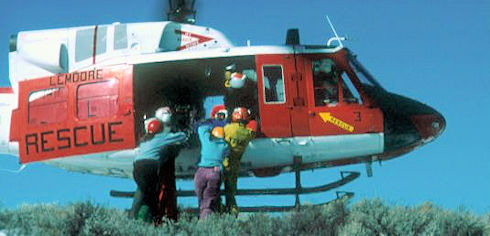
Remember that the sound of a helicopter creates a sense of urgency and excitement that is very difficult to control, especially for individuals who have little or no experience. Stay as calm as possible, don’t rush, and think through all your actions.
After the helicopter lands, the crew will take over the operation and other help will not usually be required. In some cases, however, team members might be requested to assist, especially if there is loading or unloading to be done. The helicopter crew will then consult with the overhead team and decide what is to be done and in what order. Eventually, however, individual team members at the helibase will usually be transported into the field in the helicopter.
If you are to be transported, listen very carefully to the briefing that will be given by a crew member. If you don’t understand something, ask questions. During this process, each team member will be asked for their weight plus the weight of their equipment; have an accurate figure.
The first, and most important, rule is to NEVER approach or depart a helicopter, even if the rotor blades are completely stopped, until either the pilot or a crew member signals you to do so. Sometimes the pilot will have to move the aircraft around to find the most stable landing spot, or a sudden take off might be required because of a mechanical problem. When directed to approach or depart, do so from the front or side of the helicopter so the pilot can see you. However, never approach or depart a Blackhawk helicopter via the front. Especially when idling, the main rotor tip of a Blackhawk may only be three to five feet above the ground. Never go towards the rear of the helicopter past the skids or rear door. This will put you in danger of being hit by the tail rotor, which is very difficult to see when it is moving. If, however, you are working with one of the larger, twin-rotor helicopters, you will approach it from the rear, but only in view and under the direction of a crew member. If directed to the other side of the helicopter, move around the front, never behind or underneath. For the obvious reason, always approach from or depart to the downhill side. Approach or depart in a crouched position, keeping your head up, and eyes on the pilot. Stay as low as possible because gusty winds or harmonic imbalance between the rotor blades and the skids can cause the rotor blades to dip unexpectedly. Wear eye and ear protection, a helmet with the strap fastened, leather boots, and gloves at all times. Secure any loose objects and/or equipment. Carry any backpacks; don’t wear them. Keep all long-handled items such as ice axes and skis low and parallel to the ground. Don’t throw any gear into or out of the helicopter.
Entering and Exiting the Helicopter
Do not ever attempt to enter the helicopter unless directed to do so by the pilot or a crew member. Do not step between skid and helicopter, or stand on the skid in case the craft must unexpectedly take off. Enter the cabin slowly, carefully, and in one continuous movement. Sit where the crew member tells you, immediately attach your seat belt and/or shoulder harness, and keep it attached until directed to release it by a member of the crew. Secure any gear you might have brought on board. Unless directed otherwise, let the crew stow the rest of your gear.
While in-flight, do not touch anything, especially if you’re sitting in the front seat. Do not talk to the pilot or any crew member unless they first talk to you, or unless you notice a hazardous situation. Keep your seat belt fastened at all times and minimize any movement. Don’t drop anything from the helicopter unless approved by the pilot or a crew member.
Before exiting the aircraft, wait for a signal from the pilot or another crew member. Refasten the seat belt/shoulder harness if possible. Exit the cabin slowly, carefully, and in one continuous movement. Again, do not step between the skid and the helicopter or on the skid.
Other Situations
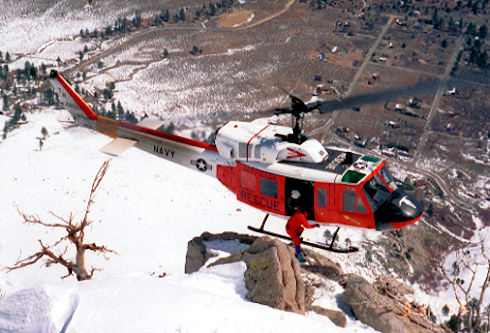
In some extreme cases, the pilot might not have room for a normal takeoff or landing and will have to utilize a one-skid landing. In this scenario, the pilot will place one skid, or the tip of one or both skids, on a ground feature while maintaining full power to keep the helicopter level and in the air. You will then step out onto the skid or that ground feature. It is critical in this situation to enter or leave slowly, carefully, and in one continuous motion.
If there aren’t any adequate land features to make a one-skid landing, it might be necessary for you to enter or exit the aircraft while it is in a hover. Obviously in this scenario, the helicopter is at its most unstable and entering or leaving slowly, carefully, and in one continuous motion is absolutely paramount.
You also might be requested to assist in carrying a litter and placing it in the helicopter while the helicopter is airborne. This is not a job for an inexperienced member or for one who has any difficulty keeping calm in a crisis. In this situation, litter bearers are not usually in very stable positions while approaching and loading the litter. And, all the while, the helicopter’s engine is screaming, the rotor blades are whirling only a few feet above everyone’s head, the downwash from the blades is intense, foreign objects are being blown all over the place, etc. It goes without saying that this is a very intense experience.
Final Thought
If you spend any time at all on a search and rescue team, you will eventually experience a helicopter rescue, either as an observer, a helper, or a victim. The procedure has always been, and will probably always be, controversial. Forest managers and back country users sometimes complain that the use of helicopters in the wilderness interrupts an outdoor user’s wilderness experience. But, even though search and rescue teams do try to remain independent of helicopter support in case it’s not available, and it is in fact intrusive, this will continue be the method of choice because of its speed and efficiency. Individuals responsible for search and rescue must also consider the liability they assume if helicopter support is available and not utilized. And, finally, if they’re honest with themselves, most back country users, including rangers, will admit that, no matter what their philosophy concerning helicopters in the wilderness may be, if they or one of their loved ones is seriously injured in the mountains, any thoughts or discussion will not be centered on the ethics of helicopter use in the wilderness, but on why is it taking the damn thing so long to get here.